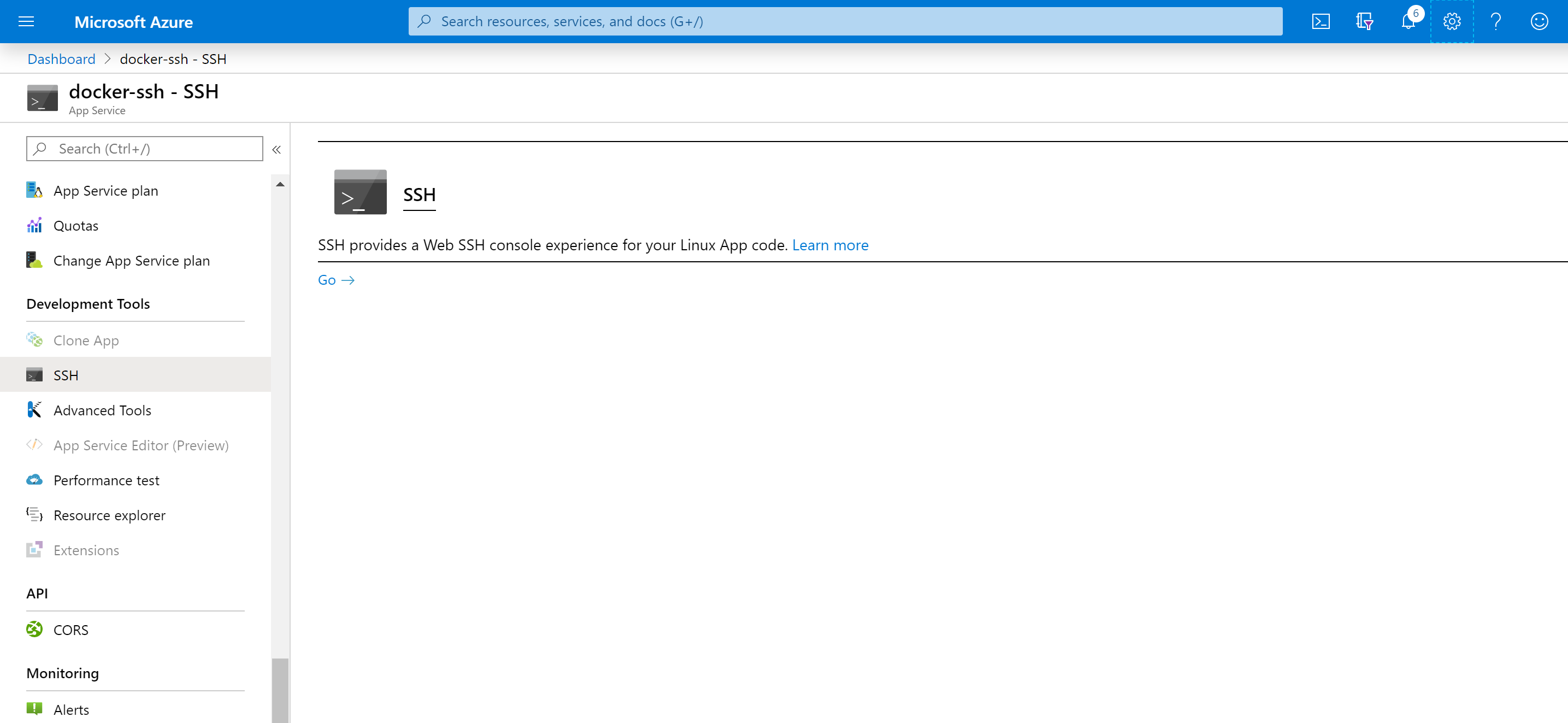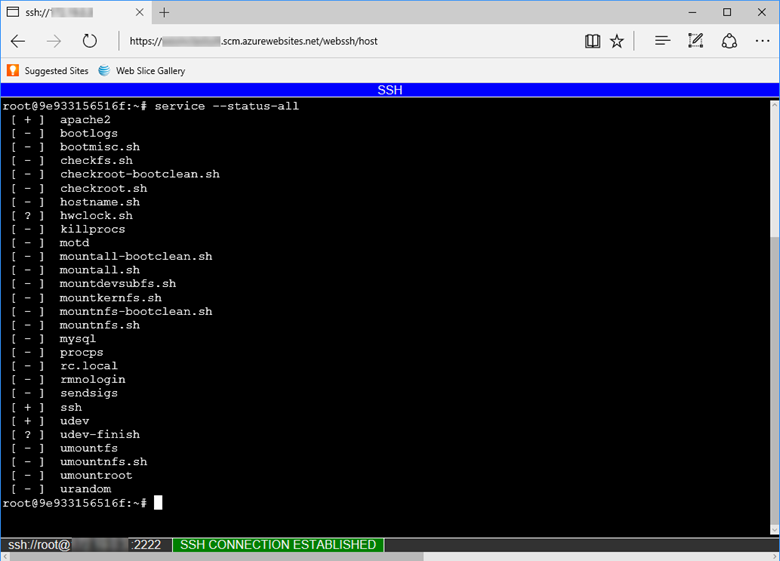Note
Access to this page requires authorization. You can try signing in or changing directories.
Access to this page requires authorization. You can try changing directories.
Secure Shell (SSH) can be used to execute administrative commands remotely to a container. App Service provides SSH support directly into an app hosted in a Windows custom container.
Windows custom containers don't require any special settings for the browser SSH session to work. SSH sessions through Azure CLI are not supported.

Secure Shell (SSH) can be used to execute administrative commands remotely to a container. App Service provides SSH support directly into an app hosted in a Linux container (built-in or custom).
The built-in Linux containers already have the necessary configuration to enable SSH sessions. Linux custom containers require additional configurations to enable SSH sessions. See Enable SSH.

You can also connect to the container directly from your local development machine using SSH and SFTP.
Open SSH session in browser
To open a direct SSH session with your container, your app should be running.
Use the az webapp ssh command.
If you're not yet authenticated, you're required to authenticate with your Azure subscription to connect. Once authenticated, you see an in-browser shell, where you can run commands inside your container.

Open SSH session with Azure CLI
Using TCP tunneling you can create a network connection between your development machine and Linux containers over an authenticated WebSocket connection. It enables you to open an SSH session with your container running in App Service from the client of your choice.
To get started, you need to install Azure CLI. To see how it works without installing Azure CLI, open Azure Cloud Shell.
Open a remote connection to your app using the az webapp create-remote-connection command. Specify <subscription-id>, <group-name> and <app-name> for your app.
az webapp create-remote-connection --subscription <subscription-id> --resource-group <resource-group-name> -n <app-name> &
Tip
& at the end of the command is just for convenience if you are using Cloud Shell. It runs the process in the background so that you can run the next command in the same shell.
Note
If this command fails, make sure remote debugging is disabled with the following command:
az webapp config set --resource-group <resource-group-name> -n <app-name> --remote-debugging-enabled=false
The command output gives you the information you need to open an SSH session.
Verifying if app is running....
App is running. Trying to establish tunnel connection...
Opening tunnel on addr: 127.0.0.1
Opening tunnel on port: <port-output>
SSH is available { username: root, password: Docker! }
Ctrl + C to close
Open an SSH session with your container with the client of your choice, using the local port provided in the output (<port-output>). For example, with the linux ssh command, you can run a single command like java -version:
ssh [email protected] -m hmac-sha1 -p <port-output> java -version
Or, to enter a full SSH session, just run:
ssh [email protected] -m hmac-sha1 -p <port-output>
When being prompted, type yes to continue connecting. You are then prompted for the password. Use Docker!, which was shown to you earlier.
Warning: Permanently added '[127.0.0.1]:21382' (ECDSA) to the list of known hosts. [email protected]'s password:
Once you're authenticated, you should see the session welcome screen.
_____
/ _ \ __________ _________ ____
/ /_\ \___ / | \_ __ \_/ __ \
/ | \/ /| | /| | \/\ ___/
\____|__ /_____ \____/ |__| \___ >
\/ \/ \/
A P P S E R V I C E O N L I N U X
0e690efa93e2:~#
You are now connected to your connector.
Try running the top command. You should be able to see your app's process in the process list. In the example output below, it's the one with PID 263.
Mem: 1578756K used, 127032K free, 8744K shrd, 201592K buff, 341348K cached
CPU: 3% usr 3% sys 0% nic 92% idle 0% io 0% irq 0% sirq
Load average: 0.07 0.04 0.08 4/765 45738
PID PPID USER STAT VSZ %VSZ CPU %CPU COMMAND
1 0 root S 1528 0% 0 0% /sbin/init
235 1 root S 632m 38% 0 0% PM2 v2.10.3: God Daemon (/root/.pm2)
263 235 root S 630m 38% 0 0% node /home/site/wwwroot/app.js
482 291 root S 7368 0% 0 0% sshd: root@pts/0
45513 291 root S 7356 0% 0 0% sshd: root@pts/1
291 1 root S 7324 0% 0 0% /usr/sbin/sshd
490 482 root S 1540 0% 0 0% -ash
45539 45513 root S 1540 0% 0 0% -ash
45678 45539 root R 1536 0% 0 0% top
45733 1 root Z 0 0% 0 0% [init]
45734 1 root Z 0 0% 0 0% [init]
45735 1 root Z 0 0% 0 0% [init]
45736 1 root Z 0 0% 0 0% [init]
45737 1 root Z 0 0% 0 0% [init]
45738 1 root Z 0 0% 0 0% [init]
Next steps
You can post questions and concerns on the Azure forum.
For more information on Web App for Containers, see: